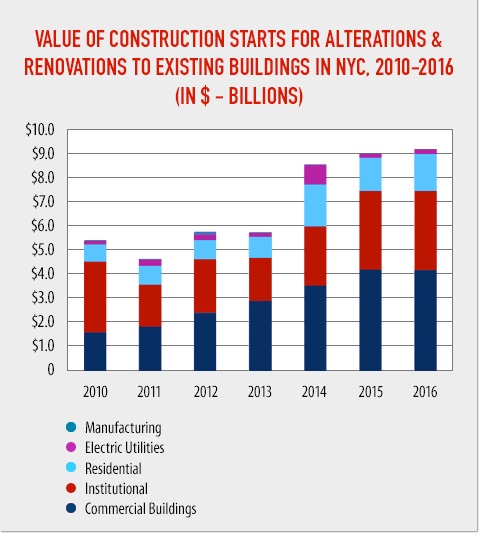The New York City Department of Buildings (DOB) issued 5,641 permits, with a combined value of $9.3 billion, for alterations and renovations (A&R) to existing buildings in 2016, according to a New York Building Congress (NYBC) analysis of construction data from Dodge Data & Analytics.
This marks the third consecutive year in which the value of building permits for construction work on existing buildings has increased. In 2015, the DOB issued 4,927 permits with a total combined value of $9.1 billion. Building owners were granted 4,964 permits for $8.7 billion in A&R work in 2014, and 3,991 permits for $5.9 billion in 2013.
For the three-year period from 2014 through 2016, the value of A&R permits averaged $9.0 billion per year, an increase from an average of $5.5 billion annually from 2011 through 2013.
“Interior construction work is the unsung hero of the current building boom,” NYBC president and CEO Carlo A. Scissura said in a statement. “While all eyes are understandably focused on the brand new office and residential towers that are piercing the New York City skyline, an extraordinary amount of important construction work is occurring, largely under the radar, throughout the five boroughs.”
A&R by building type
Commercial building owners have invested the most in A&R in each of the past six years. The commercial sector, which is dominated by office buildings, hotels, and retail, accounted for 46 percent of all permits by value in 2016, which is in line with the six-year average of 45 percent.
The primary driver in the commercial sector has been office construction. As a result of landlords making upgrades to their buildings and individual tenants building out or renovating their spaces, office work has accounted for more than 70 percent of all commercial A&R permits and approximately one-third of all A&R permits over the past six years.
“Throughout New York City’s existing inventory of nearly 500 million sq. ft. of office space, landlords and tenants are investing billions of dollars to make their spaces more efficient, sustainable, and technologically-advanced,” Scissura said. “They are doing so partly in response to increased competition from newer buildings and the evolving demands of the 21st century workplace.”
Institutional work, which includes public schools, higher education, hospitals, entertainment and cultural facilities, and government buildings, is the second biggest driver of A&R work throughout the five boroughs, accounting for 35 percent of all A&R permits by value last year and about 34 percent over the past six years.
Multi-family apartment buildings accounted for approximately 16 percent of all A&R permits issued in 2016 as well as over the past six years.
Among commercial structures, hotels typically cost much more to renovate than space in office buildings, while fit-outs of stores are much less costly than office space improvements. In the institutional market, school improvements are the costliest, averaging more than $3 million per permit authorization over the period, while upgrades in existing hospitals tend to be smaller and more focused, averaging less than $2 million per permit. Across all building types, the most expensive upgrades entail miscellaneous nonresidential structures, like improvements to transit stations and park facilities.
Borough breakdown
Manhattan accounted for nearly 70 percent of all A&R permits by value in 2016, thanks to its 93 percent share of the office work. Brooklyn was a distant second in total A&R work at nearly 13 percent, followed by Queens at 9 percent, the Bronx at 7 percent, and Staten Island at 1 percent.
Manhattan also led the institutional sector last year with 55 percent of the A&R permits by value. Brooklyn placed second at 16 percent, followed by the Bronx at 14 percent, Queens at just under 14 percent, and Staten Island at less than 2 percent.
In the commercial sector, Manhattan led with 86 percent of A&R permits by value, followed by Brooklyn at 8 percent, Queens at 3 percent, the Bronx at 2 percent, and Staten Island at 1 percent.
The residential sector followed roughly the same order, with Manhattan accounting for nearly 58 percent of the work, followed by Brooklyn and Queens at 17 percent each, the Bronx at 7 percent, and Staten Island at less than 1 percent.

